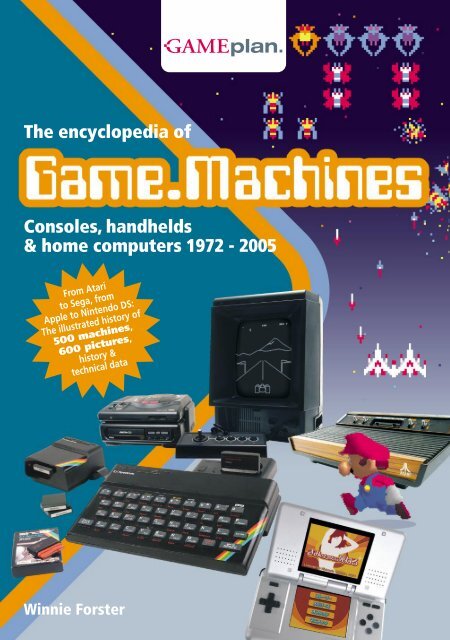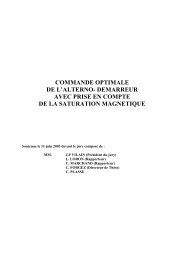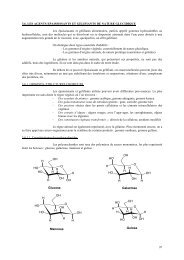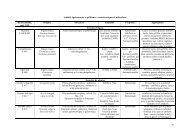Consoles, handhelds & home computers 1972 - 2005 The - UTC
Consoles, handhelds & home computers 1972 - 2005 The - UTC
Consoles, handhelds & home computers 1972 - 2005 The - UTC
You also want an ePaper? Increase the reach of your titles
YUMPU automatically turns print PDFs into web optimized ePapers that Google loves.
<strong>The</strong> encyclopedia of<br />
<strong>Consoles</strong>, <strong>handhelds</strong><br />
& <strong>home</strong> <strong>computers</strong> <strong>1972</strong> - <strong>2005</strong><br />
From Atari<br />
to Sega, from<br />
Apple to Nintendo DS:<br />
<strong>The</strong> illustrated history of<br />
500 machines,<br />
600 pictures,<br />
history &<br />
technical data<br />
Winnie Forster
2<br />
Contents<br />
Preface 4<br />
Explanation of hardware chapters 6<br />
Introduction to game storage media 7<br />
First era: Birth of electronic games.<br />
Mainframes, arcades and TV games 10<br />
<strong>1972</strong> Magnavox Odyssey 14<br />
1976 Saba Fairchild 16<br />
1977 TRS-80 17<br />
1977 Apple II 19<br />
1977 CBM Pet 23<br />
1977 Atari VCS 24<br />
1978 Interton VC4000 28<br />
1978 Philips G7000 30<br />
1979 NEC PC-8001 33<br />
1979 Atari 800 34<br />
1979 Sharp MZ 39<br />
1979 Mattel Intellivision 40<br />
1979 Microvision 43<br />
1981 Sinclair ZX81 44<br />
1981 Texas Instruments TI99/4 45<br />
1981 Commodore VC 20 46<br />
Second era: Videogame crash and<br />
<strong>home</strong> computer success story 48<br />
1982 CBS Colecovision 50<br />
1982 Entex Adventurevision 53<br />
1982 Vectrex 54<br />
1982 Hanimex HMG 2650 56<br />
1982 Sinclair Spectrum 58<br />
1982 Acorn BBC B 61<br />
1982 Commodore C 64 62<br />
1982 VT Creativision 67<br />
1982 Atari 5200 68<br />
1982 Sharp X1 70<br />
1983 Oric-1 72<br />
1983 MSX 74<br />
1983 Sega SG-1000 & Master System 80<br />
1983 Nintendo Famicom & NES 84<br />
1984 Epoch Super Cassettevision 89<br />
1984 Commodore 16 & Plus/4 90<br />
1984 Atari 7800 92<br />
1984 Amstrad CPC 94<br />
Third era: 16-Bit 96<br />
1984 IBM PC-AT 98<br />
1984 Apple Mac 100<br />
1985 Atari ST 104<br />
1985 Commodore Amiga 106<br />
1985 Enterprise 112<br />
1987 Acorn Archimedes 113<br />
1987 NEC PC-Engine 114<br />
1987 Sharp X68000 120<br />
1988 Sega Mega Drive 122<br />
1989 Nintendo Game Boy 128<br />
1989 Atari Lynx 132<br />
1989 FM Towns 134<br />
1990 SNK Neo Geo 136<br />
1990 Sega Game Gear 139<br />
1990 Super Nintendo 140
Fourth era: Rendered crazy 144<br />
1991 Philips CDi 146<br />
1991 Supervision 149<br />
1993 Atari Jaguar 150<br />
1993 Panasonic 3DO 152<br />
1994 Sega Saturn 154<br />
1994 Sony PlayStation 158<br />
1994 NEC PC-FX 162<br />
1995 Nintendo Virtual Boy 163<br />
1996 Nintendo 64 164<br />
1996 Bandai Pippin 168<br />
1997 Tiger Gamecom 169<br />
Fifth era: <strong>The</strong> 21st century:<br />
Caught in the net of gaming 170<br />
1998 Sega Dreamcast 172<br />
1998 Neo Geo Pocket 176<br />
1999 Bandai Wonderswan 178<br />
2000 Sony PlayStation 2 180<br />
2000 Nuon 183<br />
2001 Nintendo Game Boy Advance 184<br />
2001 Microsoft Xbox 188<br />
2001 Nintendo Gamecube 191<br />
2002 Gamepark GP32 194<br />
2003 Nokia N-Gage 195<br />
2004 Nintendo DS 196<br />
2004 Sony PSP 197<br />
Other formats: Home <strong>computers</strong> 198<br />
Other formats: Game consoles 200<br />
Appendix: Technical data<br />
8-Bit <strong>home</strong> <strong>computers</strong> 202<br />
8-Bit and 16-Bit game consoles 204<br />
16-Bit <strong>home</strong> <strong>computers</strong> 206<br />
32-Bit and CD-ROM consoles 208<br />
64-Bit and DVD consoles 210<br />
Handhelds 212<br />
Multimedia <strong>handhelds</strong> 214<br />
Technical data: Explanations 215<br />
Index A: Hardware 216<br />
Index B: Games 220<br />
Bibliography 224<br />
Imprint 224<br />
Bandai Wonderswan<br />
Tare Panda no Gunpey<br />
Edition (Japan, 2001)<br />
3
104<br />
<strong>The</strong> Tramiel clan extended the Atari range with a `Jackintosh´. Despite similar technology,<br />
the 520 ST and its variants couldn’t match the audio and visuals of Commodore’s Amiga.<br />
Atari ST<br />
USA, 1985<br />
In 1984, while devising its 16-Bit computer range, Atari<br />
invested in the Amiga company, owned by ex-employee Jay<br />
Miner. However, a bullish negotiating-style drove the<br />
hardware team to competitor Commodore, which promptly<br />
swallowed Amiga and released a computer of the same<br />
name simultaneously to the Atari ST.<br />
Miner’s graphics chips were missing from the ST, but other<br />
than that it was similar to the Amiga: Both machines used a<br />
Motorola 68000 CPU, 3.5” disks and a mouse as input<br />
device, and both enticed punters with a graphical user<br />
interface. GEM was the name given to Atari’s GUI with its<br />
Units sold: 6 Million<br />
Number of games: 1,000<br />
Game storage: Disk<br />
Games developed until: 1994<br />
Musicians and DTP artists bought their Atari ST with<br />
the 12” monitor SM 146 and got a small, but crisp picture.<br />
small drive and drawer symbols accompanied by the<br />
`Tramiel Operating System´ (TOS). <strong>The</strong> Atari ST was cheaper<br />
than other 16-Bit machines and was supported by many<br />
games manufacturers. 1987 turned out to be its most<br />
successful year: In the US, the real-time RPG Dungeon<br />
Master was released, along with Dan `Choplifter´ Gorlins’<br />
Typhoon Thompson and Midi Maze which networked 16<br />
<strong>computers</strong> anticipating the deathmatches of the ‘90s. After<br />
that, the scene shifted to Europe. Prominent programmers<br />
like the Bitmap Brothers (Speedball, Cadaver), Eric Chahi<br />
(Another World), the adventure specialists Magnetic Scrolls<br />
as well as 3D pioneers Paul Woakes (Damocles) and Jez<br />
French adventure artists dropped 8-Bit in favor<br />
of the ST: Future Wars by newcomers Delphine.<br />
San (Starglider) supported the platform right into the ‘90s.<br />
Germany was another stronghold for Atari, where Thalion<br />
developed mainly for the ST, releasing huge RPGs<br />
(Dragonflight) and fast action games (Wings of Death).<br />
By 1990, the Amiga overtook the Atari as a graphics and<br />
games machine, but due to its MIDI port, the ST remained<br />
the first choice for professional musicians. Similarly, small<br />
DTP offices used it as an affordable alternative to Macs. <strong>The</strong><br />
final variant was the 68030-driven Falcon in 1992.<br />
New wine in old bottles: <strong>The</strong> last ST compatible was<br />
called Falcon and was audio-visually more powerful<br />
than its predecessors, though it wasn’t a success.<br />
Variants and successors<br />
In the UK, most games were developed for both ST and Amiga:<br />
A cheering Speedball 2 player from 1990.<br />
Dungeon Master was a revolution. If you didn't own an ST, you<br />
had to wait ages for a conversion of this realtime expedition.<br />
520ST 1985 <strong>The</strong> 512 K ST first shipped with a monochrome monitor, an external power supply as well as<br />
TOS on disk. It was replaced by the 260ST and 520ST+ (1 MB) and was also available as STm<br />
(with TV modulator) and STf (internal floppy drive).<br />
260ST 1986 This short-lived 520ST twin (also with 512 K, external floppy) was shipped only in Europe.<br />
1040ST 1986 A 1 MB computer with TOS in ROM and internal power supply. An `m´ in the name stands for TV<br />
modulator; `f´ for a sideward floppy drive.<br />
Mega ST 1987 A desktop PC with separate keyboard, integrated floppy, up to 4 MB memory as standard and two<br />
new chips for graphics acceleration. Professional add-ons were hard-drive and removable media with<br />
up to 60 MB as well as a DTP-suitable 19” monitor.<br />
1040STe 1989 <strong>The</strong> 520ST successor was enhanced in terms of graphics (4,096 colour palette, hardware scrolling,<br />
Blitter) and memory, shipping with 1 to 4 MB, in the UK and France along with 512 MB RAM as<br />
520STE. Apart from two ordinary 9-pin ports Atari used its own 12-pin controller ports.<br />
STacy 1989 <strong>The</strong> laptop with monochrome LCD, mini-trackball, 4 MB RAM and 40 MB hard-drive was replaced in<br />
the early ‘90s by a lighter, just as unsuccessful ST-Book (no LCD backlight, no floppy).<br />
Atari TT 1990 A compatible successor with new 68030 CPU (2 MB RAM, up to 8 MB on top of the TT’s RAM) and<br />
better graphic modes: 320x480 in 256 of 4096 colours, 640x480 in 16 colours and a monochrome<br />
mode in 1280x960 pixels. It was replaced by the Falcon.<br />
Mega STe 1991 Mega-ST successor with separate keyboard, a CPU clocked at 16 MHz, cache and an optional<br />
co-processor.<br />
Falcon 1992 A keyboard computer with integrated floppy, 68030 CPU as well as a programmable DSP, 4 to 14 MB<br />
RAM and a graphics resolution of 640x480 pixels in 16-Bit colours.<br />
105
122<br />
Trendsetter Sega commenced the age of 16-Bit consoles, becoming popular in<br />
western markets. Supporting the console were almost 1,000 games, add-ons for<br />
all purposes and tastes, as well as several upgrades.<br />
Sega Mega Drive<br />
Japan, 1988<br />
Units sold: 30 Million<br />
Number of games: 850<br />
Game storage: Cartridge, CD<br />
Games developed until: 1997<br />
Japanese games manufacturer Sega had always come<br />
in second – producing accomplished technology and<br />
brilliant arcade and console games, but lacking the<br />
worldwide success of Nintendo. In joining the 16-Bit fray,<br />
Sega finally sought to capture the market from its rival: As<br />
the successor to the Master System, the Mega Drive was<br />
released in Japan in 1988, arriving in Europe two years<br />
later.<br />
American and European gamers welcomed the new<br />
hardware: <strong>The</strong> console was technically similar to the<br />
successful Amiga and ST <strong>home</strong> <strong>computers</strong>, but<br />
graphically superior and thanks to proven and well<br />
documented chips, pretty easy to code for.<br />
Early releases like Altered Beast had good visuals, but<br />
were a let-down gameplay-wise. <strong>The</strong>reafter new<br />
cartridges went to prove both the hardware’s<br />
capabilities, as well as the creativity and talent of Sega’s<br />
developers: <strong>The</strong> RPG Phantasy Star II, the Capcom<br />
conversion Ghouls ‘n Ghosts and – a year after the<br />
launch – the excellent action skirmish Revenge of<br />
Shinobi. But in spite of Sega’s internal development<br />
teams programming full steam ahead, the large third-<br />
Sega itself created the best cartridges: Advanced Military<br />
Commander even supported the Mega Drive modem.<br />
parties held back in order to avoid complications with<br />
Nintendo. Square, Enix and Konami ignored Sega;<br />
Capcom preferred to sell licences instead of developing<br />
and publishing Sega software under its own logo.<br />
In the west, the machine was much more welcome, as<br />
developers thirsted for an alternative to Nintendo’s<br />
licence-dictatorship. At first, Atari ST and Amiga games<br />
were converted, followed by original Mega Drive game<br />
concepts. In the UK Virgin supported Sega with games<br />
and hardware distribution, in the US Electronic Arts<br />
immediately stood by Sega. Nearly all EA Sports series<br />
<strong>The</strong> peaceful dolphin Ecco was brought to life by Novotrade in<br />
Hungary, later known as Appaloosa.<br />
This is excellent vertical action: Musha Aleste was coded by<br />
Compile for Sega and published in late 1990.<br />
started out on the Mega Drive, while computer-hits like<br />
Populous, Budokan and Starflight were converted, the<br />
action-adventure Immortal even with enhanced<br />
graphics. From 1992 on, the Mega Drive became the<br />
most popular platform amongst western developers.<br />
Sega countered the introduction of the Super Nintendo<br />
with a CD-ROM upgrade: <strong>The</strong> Mega CD introduced a<br />
second 68000 chip, and was placed under the actual<br />
console, merging with it to become more powerful than<br />
any hardware. However, as few Mega Drive users bought<br />
the upgrade, the market remained too small to attract a<br />
Mickey Mouse was charming as<br />
one of the first licensed Mega Drive<br />
heroes: Castle of Illusion (1990).<br />
123
124<br />
To fight Nintendo,<br />
Sega invested heavily in<br />
internal game<br />
development (picture:<br />
Story of Thor) and...<br />
Core proved their competence and squeezed the most out<br />
of the complicated Mega CD setup: Thunderhawk<br />
Unreliable ports, area-coded lock out and dependence on a second<br />
mains outlet limited the Mega CD’s use. <strong>The</strong> picture shows the Japanese,<br />
first variant; the Mega CD II was shipped world wide in a new look.<br />
...manufactured the flat Mega Drive 2 (sparing minor details<br />
like the volume control) as well as a cheaper Mega CD device.<br />
major commitment by the software companies; developers<br />
rarely utilized the CD capacity or the power of the second<br />
CPU. Just a few months after release (12.12.1991 in<br />
Japan), the CD system was perceived to be dead whilst<br />
Nintendo’s new cartridge machine the Super Famicom<br />
replaced the market-leading NES.<br />
In the west, Sega closed in on their arch-rival selling 12 million<br />
consoles before the end of 1993 in the US alone, where<br />
A glimpse into the future: <strong>The</strong> polygon background in Silpheed<br />
streamed from CD. Smaller vehicles were rendered in realtime.<br />
the console was released as the Genesis, and where the<br />
industry veteran Tom Kalinske was in charge. According to<br />
US magazine ‘Wired’, Sega’s market share of 45% overtook<br />
Nintendo’s 44%; in Europe as many as 66% of gamers<br />
played with the Mega Drive. With Sonic the Hedgehog,<br />
Sega provided their console with a mascot that was more<br />
modern and swaggering than Mario. Now, Acclaim and<br />
Konami, previously exclusive Nintendo partners, joined<br />
Sega’s bandwagon.<br />
With adapters for the<br />
cart port, the Mega Drive<br />
played both, past and future:<br />
<strong>The</strong> Master System<br />
Converter for 8-Bit<br />
cartridges and cards was<br />
released 1992 ...<br />
In 1993, Japanese developer Treasure unleashed a late<br />
sprite- and pixel-feast starring the Gunstar Heroes.<br />
‘Sega’s Plan for World Domination’ declared Wired as it put<br />
the blue hedgehog on its cover and quoted EA’s Bing<br />
Gordon: ‘<strong>The</strong> Genesis has an older custom base than<br />
Nintendo. And that’s the growth market for the back half of<br />
the ‘90s.’<br />
Gordon was eventually to be proved right, but it wasn’t<br />
Sega that tapped into this adult market of gamers, but Sony.<br />
Following the introduction of the Mega CD, the Sonic-<br />
... four years later, the 32X add-on with its<br />
RISC chips appeared. It required its own<br />
power supply and had only 40 games.<br />
125
126<br />
Avoiding any additional cables the Mega Jet was a<br />
combination of pad and console, designed for in-flight use.<br />
empire fell apart. Projects such as virtual reality glasses<br />
were stopped, and a hardware update, the 32X, was<br />
released but failed.<br />
<strong>The</strong> combination of Mega Drive, Mega CD and 32X<br />
made use of two 16-Bit CPUs, two RISC processors and<br />
various supporting chips. At least, in theory. Three<br />
power-supplies were required; for both players and<br />
developers, the set-up was far too complicated.<br />
With the announcement of the Saturn, Sega itself began<br />
digging the grave for the hardware. At the same time, the<br />
industry awaited Sony’s 32-Bit entry. In 1995, the<br />
cartridge market collapsed and Sega’s heyday in<br />
the west receded.<br />
In America, the Mega Drive was more successful than in<br />
Japan. <strong>The</strong> screenshot shows US hero Vectorman from 1995.<br />
<strong>The</strong> Multimega was a<br />
portable combination<br />
of Mega Drive and CD<br />
– available only in the<br />
western market.<br />
Mega Drive variants and successors<br />
Mega Drive 1988 Sega’s first 16-Bit console was shipped world wide in a similar case, but branded Genesis in the US.<br />
Including the Altered Beast cartridge it initially retailed for 21,000 yen and $189 respectively. It was<br />
later bundled with Sonic the Hedgehog.<br />
Terradrive 1991 Retailing for 148,000 yen this black desktop PC had a Mega Drive built in and hence came with two CPUs<br />
(80286, 68000) as well as a Z80A for support, up to 2.5 MB RAM, disk- and hard-drive, additional graphics<br />
and sound memory as well as connectors for monitor and TV. <strong>The</strong> European model was built and sold by<br />
Amstrad.<br />
Mega CD 1991 <strong>The</strong> CD-ROM drive expanded the Mega Drive with a second 68000 CPU, which was clocked nearly twice as<br />
fast as the console’s processor. <strong>The</strong> add-on sold 2 million units world wide and saw the release of around 80<br />
original games and about the same amount of conversions. <strong>The</strong> initial retail price in Japan was 49,800 yen.<br />
JVC Wondermega 1992 <strong>The</strong> combination of Mega Drive and Mega CD was sold from April on by JVC for 82,800 yen. Audio controls,<br />
Karaoke- and Midi ports made the Wondermega a well-equipped music and games console. <strong>The</strong> mascot<br />
Wonderdog was created by English company Core, the Wondermega however was never released in Europe.<br />
Mega Drive 2 1993 World wide case update in combination with a price reduction to 12,800 yen: <strong>The</strong> second Mega Drive is<br />
rounder and smaller than the predecessor but apart from missing headphone jack and volume control<br />
technically identical. <strong>The</strong> Mega CD also got new clothing, turned into a top loading device and shipped as<br />
the Mega CD 2 in July 1993.<br />
JVC Wondermega 2 1993 <strong>The</strong> externally revised Wondermega successor was sold for 59,800 yen by JVC (starting July) and<br />
was shipped with Midi port and a wireless infrared 6-button controller.<br />
Pioneer MegaLD 1993 <strong>The</strong> Control Pack was available as an add-on for Pioneer’s Laser Active disc player. It was pushed into a<br />
special slot and contained the complete Mega Drive hardware (chips, joypad and cartridge ports) making<br />
the disc player compatible with Sega games as well as interactive Laser Discs like Taito’s 3D ride Pyramid<br />
Patrol.<br />
Mega Jet 1994 This combo consisted of a Mega Drive and 6-button controller (port for second joypad included) and was<br />
devised for use on board the JAL and sold in Japan only (starting price: 15,000 yen). With an LC display,<br />
the compact system could have been a handheld.<br />
Multimega 1994 CD Drive, cartridge port and two CPUs in a Discman-like case: <strong>The</strong> most<br />
powerful and beautiful Mega Drive was available in limited numbers in the<br />
west only. <strong>The</strong> name used in the US was Genesis CDX.<br />
Aiwa CSD-GM1 1994 Retailing for 45,000, this ghetto blaster with integrated Mega Drive ran<br />
cartridges, Mega- and Audio-CDs as well as CD-G discs and was sold as a<br />
Karaoke machine in Japan only.<br />
32X 1994 This hardware add-on topped the Mega Drive with two Hitachi SH2 RISC<br />
processors, 2 Mbit of main- and video memory respectively, as well as new<br />
sound and graphics chips. Sold for 16,800 yen it multiplied the Mega Drive’s power,<br />
yet only 40 cartridges and CDs supported it.<br />
Nomad 1995 Console, joypad and LCD combined. <strong>The</strong> only true handheld version of the Mega Drive was sold in the US<br />
and box-moved just shortly after release. Today, it’s a collector’s item.<br />
Genesis 3 1998 <strong>The</strong> last Mega Drive was marketed by American distributor Majesco as a very compact cartridge console<br />
Varianten und Nachfolger:<br />
including the 6-button joypad.<br />
Neo Geo 1990 Das Ur-Modell wird mit einem Joyboard ausgeliefert und war in Japan kurzzeitig<br />
auch mit roten Feuerknöpfen erhältlich.<br />
Neo Geo CD 1994 Die verbilligte Hardware-Variante ohne Modulschacht (und Pad statt Joyboard)<br />
gibt´s sowohl als Front-, als auch als Top-Lader.<br />
Neo Geo CDZ 1995 Technisch nicht verbesserte Gehäuse-Variante mit Top-Lader-CD-Laufwerk.<br />
Hyper Neo Geo 64 1997 Völlig überarbeiteter 64-Bit-RISC-Nachfolger des Neo Geo/MVS, mit dem<br />
16-Bit-Systemen nicht kompatibel und nicht als Heimkonsole veröffentlicht.<br />
Für das technisch starke, aber erfolglose Arcade-System erscheinen sieben<br />
Spiele, darunter 3D- und Polygon-Updates zu Samurai Spirits und Fatal Fury.<br />
127

















